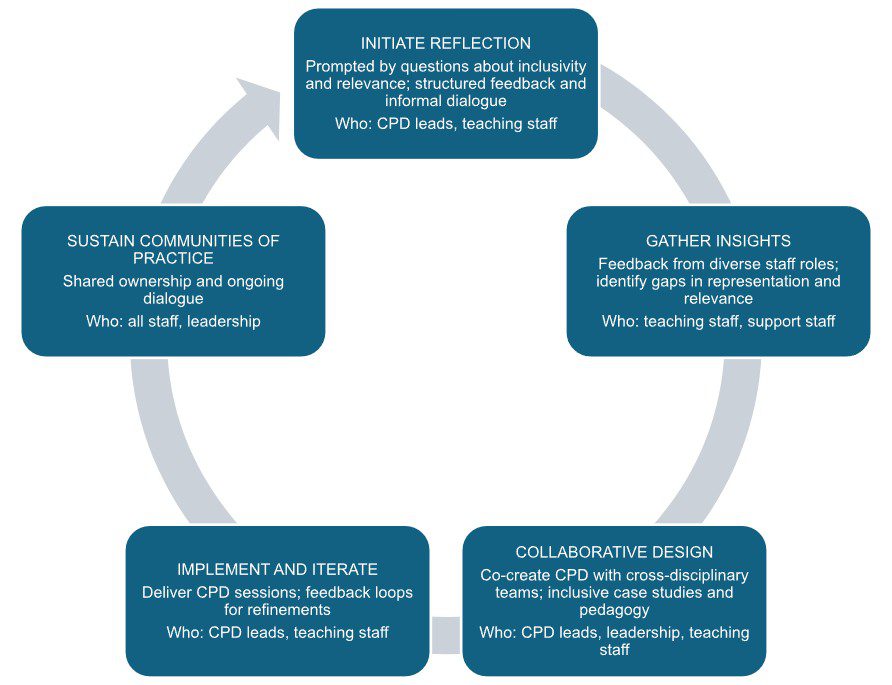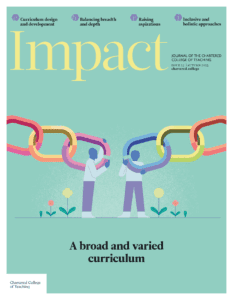Walking the talk: Reflective practice in developing an inclusive and balanced professional learning curriculum

HEATHER PENNINGTON AND ALYSON LEWIS, CARDIFF LEARNING AND TEACHING ACADEMY, CARDIFF UNIVERSITY, UK
Introduction
Professional learning is essential for teaching professionalism, as it fosters reflection, collaboration and continuous improvement in everyday practice (Salo et al., 2024; Darling-Hammond et al., 2017). While facilitators of professional learning are often adept at encouraging these practices in others, they must also undertake the brave and often uncomfortable work of critically examining their own methods. This reflective practice is essential for fostering authentic and impactful teaching experiences (Marshall et al., 2022; Brookfield, 1995).
Drawing on decades of experience as educators working across diverse teaching sectors, we engaged in an honest and reflective examination of our continuing professional development (CPD) curriculum practices. Aligning with Wenger’s (1998) concept of communities of practice, which emphasises shared learning and collective meaning-making in curriculum development, we reimagined our curriculum design through close collaboration with colleagues across disciplines and roles, to more effectively address the evolving needs of all participants.
Despite its centrality to educational improvement, CPD programmes often fail to engage the full diversityThe recognition of individual differences in terms of race, ethnicity, gender, sexual orientation, socio-economic status, physical ability, religious beliefs and other differences of staff within educational institutions. Designing and delivering an inclusive and balanced professional learning curriculum presents a significant challenge, as many programmes inadvertently marginalise certain roles, privileging dominant perspectives and creating a sense of exclusion for those in less traditionally recognised positions. This article shares our journey as CPD leads in transforming our professional learning curriculum through reflective practice. It examines how reflective practice can transform professional learning curricula, ensuring inclusivity and balance. We explore how structured reflection, collaborative design and intentional framing can create CPD programmes that resonate with all staff, offering practical strategies for fostering inclusivity.
The CPD designer’s dilemma: InclusionAn approach where a school aims to ensure that all children are educated together, with support for those who require it to access the full curriculum and contribute to and participate in all aspects of school life vs. imbalance
Despite best intentions, CPD programmes often fail to resonate with all participants, privileging certain roles while overlooking others. This imbalance is not necessarily intentional but frequently arises from a narrow framing of professional learning – from a lack of perspective rather than deliberate exclusion.
Research highlights the importance of ensuring that CPD actively integrates multiple perspectives in both content and framing, rather than simply acknowledging diverse expertise. For instance, in our early CPD initiatives, when covering formative assessment strategies, we assumed that lab technicians – who often work with students in the lab and frequently engage in dialogic learning and questioning strategies – would naturally see the relevance to their work. However, feedback from a lab technician colleague revealed a disconnect: the materials did not explicitly address their role, leaving them feeling marginalised in professional learning spaces. This highlighted an imbalance – not necessarily in content, but in how learning opportunities were framed. This realisation prompted us to re-evaluate our approach, asking difficult questions: Were we truly meeting the needs of all learners? Was our curriculum truly inclusive, reflective and sufficiently adaptive? Who is being left out of our CPD narrative?
We recognised that we needed to model the reflective practices that we espoused.
A brave conversation
Reflection is rarely a comfortable process, particularly when it challenges deeply ingrained habits, assumptions or beliefs about curriculum design (Zeichner and Liston, 1996). Schön’s (1983) concept of the reflective practitioner guided us as we embarked on a frank and collective discussion about our curriculum practices. As facilitators, we asked ourselves:
- Are we ensuring that our curriculum resonates across diverse roles and disciplines?
- Do our materials reflect the realities of contemporary teaching and learning environments?
- How can we better support a sense of belonging?
Brookfield’s (1995) work on critical reflection reminded us of the importance of examining our assumptions. With the support of colleagues across roles, we engaged in a process of co-reflection. Respecting the principle of communities of practice (Wenger, 1998), we sought to make this refinement process collaborative. Communities of practice emphasise the value of shared learning, where participants collectively negotiate meaning and develop new practices. By working alongside colleagues from diverse roles and contexts across our institution, we established a shared understanding of a richer, more inclusive vision for curriculum design. These discussions not only aimed to enrich our understanding but also strengthened our commitment to fostering inclusivity and adaptability in our curriculum.
Recognising this imbalance, we adopted a more intentional approach to redesigning our CPD materials. We ensured that they actively reflected all professional roles by incorporating diverse case studies, using inclusive language and making explicit connections to different work contexts. Through these changes, we aimed to create a more balanced and accessible professional learning experience – one that truly reflected the breadth of expertise across our institution.
Reflecting and refining: Belonging, mattering and representation
Belonging and mattering are key to developing positive relationships (Morgan and O’Hara, 2023) and are therefore central to effective professional learning. Staff engagement in CPD is strongly influenced by the extent to which their professional identity is acknowledged and meaningfully integrated into the learning process. Reflective practice (Moon, 1999) has been instrumental in addressing this gap, allowing us to redesign CPD initiatives to embody the inclusivity that we seek to foster. We have intentionally developed a CPD curriculum that is both inclusive and balanced, ensuring that it acknowledges and supports the diverse teaching and learning roles across our institution. Staff feedback revealed that some did not see their roles clearly represented in our CPD programme. To foster a more inclusive approach, we engaged in job shadowing across various roles, deepening our understanding of staff contributions to student learning and how professional development is experienced institution-wide. These insights allowed us to tailor CPD content more effectively. This process informed a redesign of CPD materials, ensuring that they fully acknowledged and supported the breadth of professional contributions to student learning.
Modelling reflective and inclusive practices
Fostering a sense of belonging requires meeting people where they are. Our CPD participants come from diverse teaching and learning environments, including educators, learning support professionals and leadership staff. Grounded in culturally responsive pedagogy (Ladson-Billings, 1995), we embed participant voices into our CPD materials through case studies, role-specific scenarios and inclusive discussions. Additionally, we adopt an educative mentoring approach, tailoring CPD conversations to participants’ unique contexts and aspirations. By actively modelling these practices, we encourage staff to adopt similar approaches in their professional settings, generating a ripple effect of inclusive teaching and learning.
Collaborative design
True inclusivity requires shared ownership. Inspired by Wenger’s (1998) concept of communities of practice, we adopted a more collaborative design, involving staff from diverse roles in the creation of learning materials.
Structured feedback has revealed key gaps in our initial approach, leading to three central strategies for inclusive CPD design:
1. Experiential bridging
-
- Conducting job-shadowing across different roles
-
- Creating ‘translation guides’ linking pedagogical theory to operational contexts
-
- Developing role-specific reflection prompts
2. Collaborative architecture
-
- Establishing ‘review panels’ with cross-role representation to evaluate CPD materials
3. Intentional representation
-
- Auditing CPD resources to ensure diverse role representation
-
- Developing parallel examples applicable across disciplines and learning environments.
Building communities of practice: Shared ownership of CPD
Wenger’s (1998) framework highlights the power of collaborative learning spaces, where professional learning is a shared responsibility. Recognising the collective expertise of staff, we adopted a community-driven approach to CPD, integrating cross-disciplinary perspectives to ensure a curriculum that reflects a diverse range of professional roles. Schlossberg’s (1989) concept of marginality and mattering further emphasises the need to create professional learning environments where all educators, who are continually navigating transition and change in their practice, feel valued and supported in their journey of reflection and refinement.
Reflective leadership: Modelling vulnerability
Educators engaged in developing an inclusive and balanced curriculum often take on the role of facilitators in professional learning. To truly embody the reflective and inclusive practices that they promote, they must ‘walk the talk’. This process requires vulnerability, humility and a readiness to learn from feedback. It also involves creating spaces where reflection and dialogue are not only encouraged but normalised, fostering a professional culture of mutual respect and continuous growth. Through this reflective journey, we not only enhanced our curriculum but also strengthened our sense of professionalism.
Aligning with Bronfenbrenner’s (1979) ecological systems theory, we acknowledge the interplay between individual and institutional contexts, ensuring that our CPD curriculum remains responsive to the evolving needs of professional learning. By embracing vulnerability, reflective leaders can model adaptive practices, demonstrating an ongoing commitment to inclusivity.
Practical strategies for inclusive CPD
For CPD leaders seeking to foster an inclusive and balanced professional learning curriculum, we propose four key strategies:
1. Contextual adaptation
-
- Design flexible session formats with role-specific breakout discussions
-
- Engage in job-shadowing to understand the CPD needs of different roles
2. Structural collaboration
-
- Invite diverse staff members to co-design and review CPD content
3. Intentional representation and framing
-
- Audit materials for role diversity and adapt language to be inclusive of all staff
4. Iterative evaluation and feedback
-
- Implement regular feedback loops and impact assessments to refine CPD offerings.
The ripple effect: When CPD works for all
By implementing these strategies, we have shifted our CPD curriculum from a passive experience into an active, collaborative process, where staff become co-creators of their professional learning (see Figure 1). Wenger (1998) describes this as a true community of practice, where professional learning evolves from an isolated event into a dynamic, institution-wide shared endeavour.

Figure 1: A reflective and inclusive CPD design process
Conclusion
Curriculum development is most effective when it embodies the very principles that it seeks to instil. For educators, this means embracing reflection, critically examining our own practices and actively engaging with feedback. It requires the courage to question our assumptions and be open to change, even when it’s uncomfortable. By seeking the collaborative input of our community – across all roles and disciplines – we can create curricula that are not only relevant but also truly responsive to the evolving needs of all learners.
This work is undoubtedly challenging, yet it is also profoundly rewarding. It provides an opportunity to lead by example, demonstrating that teaching professionalism goes beyond promoting best practices – it involves continuously embracing growth and transformation. For those of us designing and delivering curricula, the path forward requires bravery: critically reflecting on our own practice and cultivating an inclusive, collaborative culture where everyone’s voice matters. Through this collective effort, we can inspire a culture of professionalism that is reflective, dynamic and truly transformative.
As CPD designers, we must model the inclusive practices that we wish to see. This means committing to shared ownership of professional learning and ensuring that CPD reflects the diverse needs and contributions of all staff. When professional learning is co-created, it moves from being imposed to being collaboratively built. As Ladson-Billings (1995) asserts, relevance is the foundation of engagement – and engagement is the key to meaningful change. By embedding reflective practice, inclusive design and shared ownership, we create a CPD environment where every staff member, regardless of role, feels valued, included and empowered.
- Bronfenbrenner U (1979) The Ecology of Human Development: Experiments by Nature and Design. Cambridge, MA: Harvard University Press.
- Brookfield SD (1995) Becoming a Critically Reflective Teacher. San Francisco: Jossey-Bass.
- Darling-Hammond L, Hyler ME and Gardner M (2017) Effective Teacher Professional Development. Palo Alto, CA: Learning Policy Institute.
- Ladson-Billings G (1995) Toward a theory of culturally relevant pedagogy. American Educational Research Journal 32(3): 465–491.
- Marshall T, Keville S, Cain A et al. (2022) Facilitating reflection: A review and synthesis of the factors enabling effective facilitation of reflective practice. Reflective Practice 23(4): 483–496.
- Moon J (1999) Reflection in Learning and Professional Development: Theory and Practice. London: Kogan Page.
- Morgan J and O’Hara M (2023) Belonging, mattering and becoming: Empowering education through connection. Advance HE. Available at: www.advance-he.ac.uk/news-and-views/belonging-mattering-and-becoming-empowering-education-through-connection (accessed 16 July 2025).
- Salo P, Francisco S and Olin Almqvist A (2024) Understanding professional learning in and for practice. Professional Development in Education 50(3): 444–459.
- Schlossberg NK (1989) Marginality and mattering: Key issues in building community. New Directions for Student Services 48: 5–15.
- Schön DA (1983) The Reflective Practitioner: How Professionals Think in Action. New York: Basic Books.
- Wenger E (1998) Communities of Practice: Learning, Meaning, and Identity. Cambridge: Cambridge University Press.
- Zeichner KM and Liston DP (1996) Reflective Teaching: An Introduction. Mahwah, NJ: Lawrence Erlbaum Associates.










